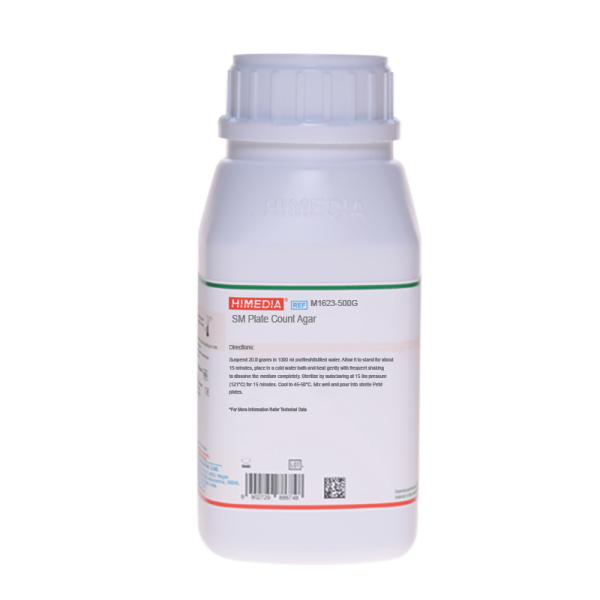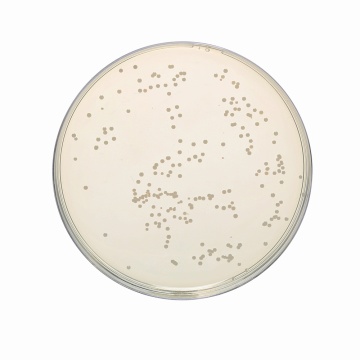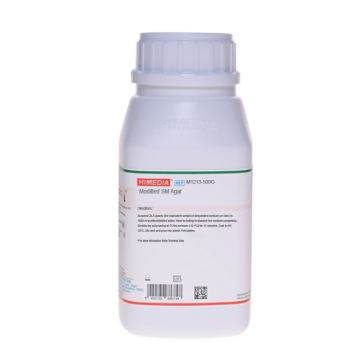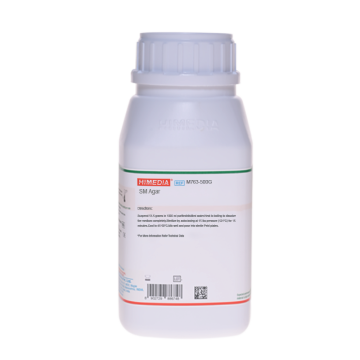 Your enquiry has been submitted
Your enquiry has been submitted
SM Plate Count Agar
Intended Use
Recommended for determining the microbial count in milk and dairy products.
Composition**
| Ingredients | g / L |
|---|---|
| Tryptone | 5.000 |
| Yeast extract | 2.500 |
| SM powder # | 1.000 |
| Dextrose (Glucose) | 1.000 |
| Agar | 10.500 |
Final pH ( at 25°C) 7.0±0.2
**Formula adjusted, standardized to suit performance parameters
# Equivalent to Skim milk powder
Directions
Suspend 20 grams in 1000 ml purified / distilled water. Allow it to stand for about 15 minutes, place in a cold water bath and heat gently with frequent shaking to dissolve the medium completely. Sterilize by autoclaving at 15 lbs pressure (121°C) for 15 minutes. Cool to 45-50°C. Mix well and pour into sterile Petri plates.
Principle And Interpretation
SM Plate Count Agar complies with the recommendation of the International Dairy Federation (1,2) and the DIN Norm 10192 (3) for the examination of milk and dairy products. The media is also recommended by ISO 4833-1:2013 and ISO 17410:2019 (4,5). Tryptone provides amino acids and other complex nitrogenous substances. Yeast extract supplies vitamin B complex. Addition of skim milk in the medium makes the conditions optimal for microorganisms which grow in milk. A wide range of microorganisms can be cultured and enumerated on this medium.
Type of specimen
Dairy samples
Specimen Collection and Handling
For dairy samples, follow appropriate techniques for sample collection and processing as per guidelines (6,7). After use, contaminated materials must be sterilized by autoclaving before discarding.
Warning and Precautions
Read the label before opening the container. Wear protective gloves/protective clothing/eye protection/ face protection. Follow good microbiological lab practices while handling specimens and culture. Standard precautions as per established guidelines should be followed while handling specimens. Safety guidelines may be referred in individual safety data sheets.
Limitations
- Further biochemical and serological tests must be carried out for complete identification.
- Individual organisms differ in their growth requirement and may show variable growth patterns on the medium.
- Each lot of the medium has been tested for the organisms specified on the COA. It is recommended to users to validate the medium for any specific microorganism other than mentioned in the COA based on the user’s unique requirement.
Performance and Evaluation
Performance of the medium is expected when used as per the direction on the label within the expiry period when stored at recommended temperature.
Quality Control
Appearance Cream to yellow homogeneous free flowing powder
Gelling Firm, comparable with 1.05% Agar gel.
Colour and Clarity of prepared medium Light yellow coloured clear to slightly opalescent gel forms in Petri plates
Reaction Reaction of 2.0% w/v aqueous solution at 25°C. pH : 7.0±0.2
pH 6.80-7.20
Cultural Response
Cultural characteristics observed after an incubation at 35-37°C for 18-24 hours.
| Organism | Inoculum (CFU) | Growth | Recovery |
|---|---|---|---|
| Staphylococcus aureus subsp. aureus ATCC 25923 (00034*) | 50-100 | luxuriant | >=70% |
| Lactococcus lactis spp. lactis ATCC 19435 (00016*) | 50-100 | luxuriant | >=70% |
| Listeria monocytogenes ATCC 19118 | 50-100 | Luxuriant | >=70% |
| Bacillus cereus ATCC 11778 (00001*) | 50-100 | luxuriant | >=70% |
| Escherichia coli ATCC 25922 (00013*) | 50-100 | luxuriant | >=70% |
| Pseudomonas aeruginosa ATCC 27853 (00025*) | 50-100 | luxuriant | >=70% |
| Candida albicans ATCC 10231 (00054*) | 50-100 | luxuriant | >=70% |
Key : *Corresponding WDCM numbers.
Storage and Shelf Life
Store between 10-30°C in a tightly closed container and the prepared medium at 20-30°C. Use before expiry date on the label. On opening, product should be properly stored dry, after tightly capping the bottle in order to prevent lump formation due to the hygroscopic nature of the product. Improper storage of the product may lead to lump formation. Store in dry ventilated area protected from extremes of temperature and sources of ignition. Seal the container tightly after use. Product performance is best if used within stated expiry period.
Disposal
User must ensure safe disposal by autoclaving and/or incineration of used or unusable preparations of this product. Follow established laboratory procedures in disposing of infectious materials and material that comes into contact with sample must be decontaminated and disposed of in accordance with current laboratory techniques (8,9).
Reference
- DIN Deutsches Institut für Normunge.V.:Mikrobiologische Milchuntersuchung;Bestimmung der Keimzah (Referenzverfahren) - DIN 10192.1
- Internationaler Milchwirtschaftsverband: Milch u. Milchprodukte, Zählung von Mikroorganismen (Koloniezählung bei 30°C) - Internationaler Standard 100 (1991).
- Internationaler Milchwirtschaftsverband: Flüssige Milch. Zählung von psychotrophen Mikroorganismen bei 6,5°C). (Koloniezählung- Internationaler Standard 101 (1991).
- ISO 4833-1:2013 Microbiology of the food chain — Horizontal method for the enumeration of microorganisms — Part 1: Colony count at 30°C by the pour plate technique.
- ISO 17410:2019 Microbiology of the food chain—Horizontal method for the enumeration of psychrotrophic microorganisms.
- American Public Health Association, Standard Methods for the Examination of Dairy Products, 1978, 14th Ed., Washington D.C.
- Wehr H. M. and Frank J. H., 2004, Standard Methods for the Microbiological Examination of Dairy Products, 17th Ed., APHA Inc., Washington, D.C.
- Isenberg, H.D. Clinical Microbiology Procedures Handbook 2nd Edition.
- Jorgensen, J.H., Pfaller, M.A., Carroll, K.C., Funke, G., Landry, M.L., Richter, S.S and Warnock., D.W. (2015) Manual of Clinical Microbiology, 11th Edition. Vol. 1.
| Product Name | SM Plate Count Agar |
|---|---|
| SKU | M1623 |
| Product Type | Regular |
| Physical Form | Powder |
| Origin | Animal |
| Packaging type | HDPE |
| References | 1. DIN Deutsches Institut für Normung e.V.: Mikrobiologische Milchuntersuchung; Bestimmung der Keimzahl(Referenzverfahren) - DIN 10192. |
| Customized Product Available | No |








